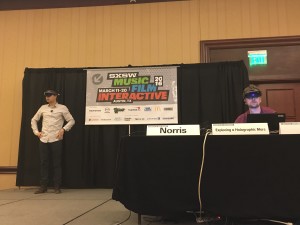 “Physicists ruin everything. All they want to talk about is limits, laws, and principles. They’re making space exploration challenging,” Jeff Norris, Mission Operations Innovation Lead of NASA Jet Propulsion Laboratory, said. The team at NASA’s Jet Propulsion Lab are doing the unthinkable and bringing an amazing new tool to space exploration.
“Physicists ruin everything. All they want to talk about is limits, laws, and principles. They’re making space exploration challenging,” Jeff Norris, Mission Operations Innovation Lead of NASA Jet Propulsion Laboratory, said. The team at NASA’s Jet Propulsion Lab are doing the unthinkable and bringing an amazing new tool to space exploration.
This is not an easy panel to write up about, this is a must-see situation! Jeff Norris and Victor Luo brought toys and showed several amazing demos, and by toys, I mean Microsoft HoloLens. I filmed the demos and they are certainly a must-see. The NASA Jet Propulsion Lab is doing great things!
The NASA Jet Propulsion Lab is bringing 3D designs into the world and solving problems before they’re real.
“The space station is large, it’s the size of a football stadium. There are usually 6 astronauts on it. These astronauts need to understand every single part of this complicating machine. In order to do that, they need to have a lot of training on the ground, up to a year in advance. There’s so many things they have to do, thousands of procedures, and they can’t remember all of them. We give them paper procedures, but they’re hard to read. So what’s one way we can solve it? Put more people on it? No. It’s expensive to put things or people into space. But holographic procedures can build a real time application for you. If an astronaut is having a problem, they can call down to the ground and walk you through the exact procedure,” Luo said. “We empower the crew with assistance when and where they need it.”
Not only did the Jet Propulsion Lab create a tool to help with space procedures, but they also imagined a tool that could bring the surface or Mars into his or her eyes. “In doing so, this engages all the senses that we naturally have to understand environments. OnSight enables scientists to work on Mars from their offices,” Norris said.
A common question they receive is ‘Can virtual reality ever be as good as being there?’ Norris believes that this goal is not ambitious enough. “I believe VR can be better. The day we send astronauts to Mars, there will be hundreds of virtual astronauts there with them. The astronaut will take the first step, but the telenauts (virtual astronauts) will soar overhead and into the canyons beneath. We can only send just a few brave astronauts to Mars, but thousands more will join them virtually,” Norris said.
